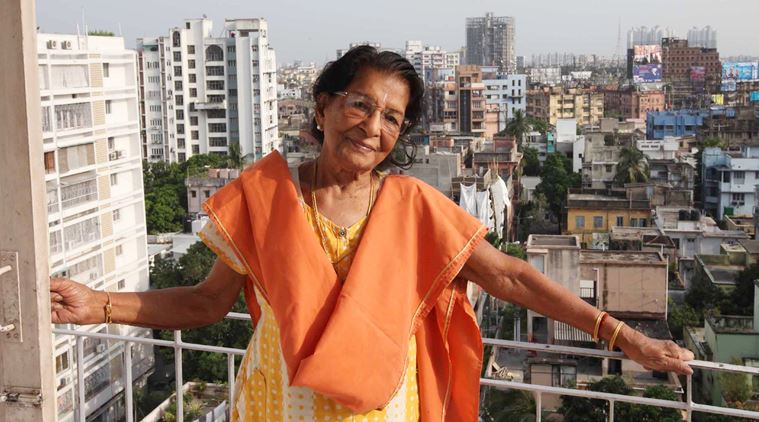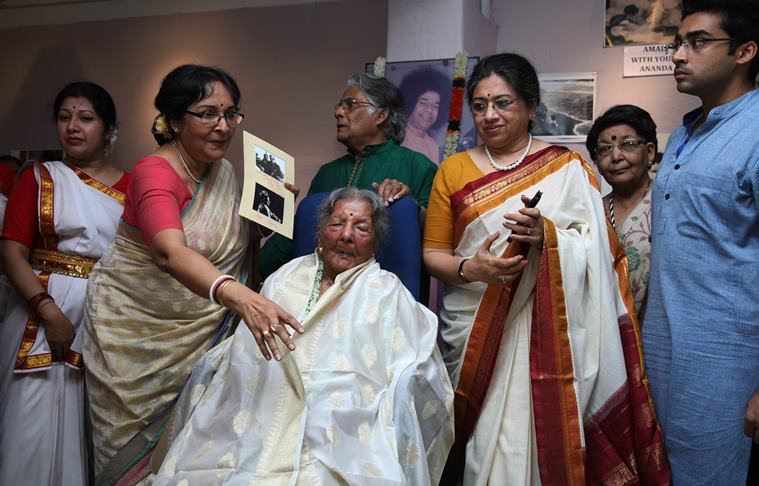 Amala Shankar was born Amala Nandy in 1919 in Jessore (now in Bangladesh), in a culturally inclined family. (Express photo by Partha Paul)
Amala Shankar was born Amala Nandy in 1919 in Jessore (now in Bangladesh), in a culturally inclined family. (Express photo by Partha Paul)
In Kalpana (1948), dance pioneer Uday Shankar’s magnum opus — the story of a young dancer who wants to set up a holistic dance academy in the Himalayas and a critique of the socio-political issues prevalent in society — is remembered for some of the most outstanding, complex and captivating dance pieces. Be it the Bharatanatyam-inspired tandav nritya with Uday and Amala as Shiva and Parvati or “Kartikeya” — a Kathakali based-piece that remains extremely distinguished — or the opening piece with its mix of folk and classical movements, Uday is accompanied by his wife and dancer Amala Shankar in all of these. While Uday was the towering figure in them, one cannot miss Amala, who not only complemented him but made the frame taller. Her precision and grace flowing out of a classical core paired with a supreme sense of rhythm remains timeless. Amala Shankar, a brilliant dancer who took on the hard work of disseminating Uday Shankar’s legacy — a blend of seven classical dance styles and folk dance forms of India — to a new generation of dancers, passed away in her sleep today. She was 101. She was also the matriarch of the Shankar family (famous sitar legend Pt Ravi Shankar’s sister-in-law, actor and dancer Mamata Shankar and sitar player Anando Shankar’s mother and dancer Tanushree Shankar’s mother-in-law).
In the Shiva and Parvati sequence, where the two are in elaborate attires and headgears similar to the ones seen in the popular bronze depictions of the Nataraja, the piece incorporates the soul of popular Indian spiritual lore — one that also finds mention in Bharata’s Natya Shastra. Bringing alive the famed pictorial parable in Chennai’s Gemini Studios, Uday depicts the cosmic cycle of creation and destruction with his vigorous, brisk movements, and the famed hasta mudra, while Amala, who plays Shiva’s feminine counterpart, responds with ‘Lasya’, the dance of aesthetic delight that symbolises eroticism through delicate movements. Together, the two create a riveting performance, the stills from which find themselves in almost every book written on Indian dance. But in a dance ballet so overshadowed by Uday, one has to see a beautiful folk performance by Amala, Jamuna ke teere, to understand what she can manage as a solo artiste. While the other pieces require more muscle, the movements in the folk piece aren’t rigorous. Dressed in a simple cotton sari, she reflects melody and mood in very delicate movements that are supple yet sharp. It’s a lesson in minimalism in dance.
 Dancer Uday Shankar with wife Amala and daughter Mamata. (Express archive photo)
Dancer Uday Shankar with wife Amala and daughter Mamata. (Express archive photo)
Born Amala Nandy in 1919 in Jessore (now in Bangladesh), in a culturally inclined family, Amala didn’t know anything about dance until she visited Paris in 1930 with her father, who was a gold shop owner and was invited to represent India at the International Colonial Exhibition in France to showcase India’s craftsmanship. He encouraged his children to read a lot, especially the works of Rabindranath Tagore and Michael Madhusudan Dutta, among others. It was in Paris that the two met the Shankar family — Uday and his three brothers, including the youngest, Ravi or Robu as he was fondly called then, and their mother, Hemangini Devi. Uday’s mother took a liking to Amala, and would dress her up in her saris. Amala mostly played with Ravi (Shankar), who used to dance in Uday’s troupe. Uday, 30 by then, was already a feted name in global dance circles. After studying at JJ School of Art in Mumbai, Uday had moved to London to study painting at the Royal College of Art. There, he choreographed two ballads titled Radha and Krishna and A Hindu Wedding. During one of these performances, he was spotted by Russian ballerina Anna Pavlova and performed with her in London and Paris. The West was in awe.
It was in Paris that Uday asked Amala to try out a few basic steps. She nailed every movement and expression he taught. Impressed, he asked his mother to convince Amala’s father to allow her to tour Europe for two months. It was around the same time that Rabindranath Tagore asked Uday to establish a holistic dance academy. In 1938, Uday set up Uday Shankar Centre for Dance. Netaji Subhash Chandra Bose, a family friend with the Nandy family, asked Amala’s father to send her to the academy to train. He agreed. Once in Almora, Amala met and learned from the other early trainees — Zohra Sehgal, her sister Uzra Butt, a teenage Guru Dutt and Ut Ali Akbar Khan, among others. Uday and Amala married in 1942.
 Amala Shankar was also the matriarch of the Shankar family (famous sitar legend Pt Ravi Shankar’s sister-in-law, actor and dancer Mamata Shankar and sitar player Anando Shankar’s mother and dancer Tanushree Shankar’s mother-in-law). (Express Photo by Partha Paul)
Amala Shankar was also the matriarch of the Shankar family (famous sitar legend Pt Ravi Shankar’s sister-in-law, actor and dancer Mamata Shankar and sitar player Anando Shankar’s mother and dancer Tanushree Shankar’s mother-in-law). (Express Photo by Partha Paul)
The centre in Almora had to be shut in the same year due to lack of funds. Uday then gave the world Kalpana, meaning imagination — a fantasy film and dance drama produced by him. It also attempted to critique the flaws in our society — religious, social and political — and how the arts and a creative education system in a good environment could help. The film was lost for many years and was screened at Cannes in 2012. A 93-year-old Amala had walked the red carpet to watch the film, which was caught in a legal battle for a long time and was finally restored by Martin Scorsese after Ravi Shankar mentioned it to him.
After years of dancing together and a long association, Amala and Uday separated a few years before Uday’s death in 1977. Amala kept teaching his style of dance, nurturing it, experimenting with it and keeping it alive for many years. Amala Shankar should also be remembered as an excellent dancer herself, whose presence in Kalpana and the cultural history of the nation can never be forgotten.